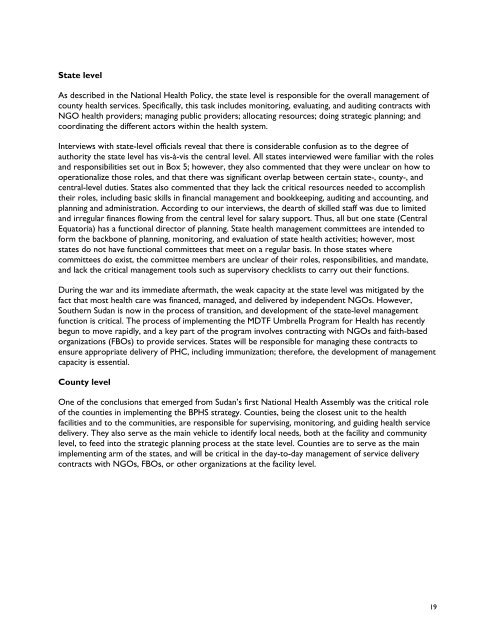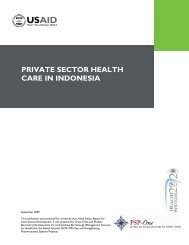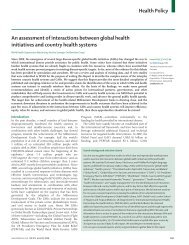southern sudan health system assessment - Health Systems 20/20
southern sudan health system assessment - Health Systems 20/20
southern sudan health system assessment - Health Systems 20/20
Create successful ePaper yourself
Turn your PDF publications into a flip-book with our unique Google optimized e-Paper software.
State level<br />
As described in the National <strong>Health</strong> Policy, the state level is responsible for the overall management of<br />
county <strong>health</strong> services. Specifically, this task includes monitoring, evaluating, and auditing contracts with<br />
NGO <strong>health</strong> providers; managing public providers; allocating resources; doing strategic planning; and<br />
coordinating the different actors within the <strong>health</strong> <strong>system</strong>.<br />
Interviews with state-level officials reveal that there is considerable confusion as to the degree of<br />
authority the state level has vis-à-vis the central level. All states interviewed were familiar with the roles<br />
and responsibilities set out in Box 5; however, they also commented that they were unclear on how to<br />
operationalize those roles, and that there was significant overlap between certain state-, county-, and<br />
central-level duties. States also commented that they lack the critical resources needed to accomplish<br />
their roles, including basic skills in financial management and bookkeeping, auditing and accounting, and<br />
planning and administration. According to our interviews, the dearth of skilled staff was due to limited<br />
and irregular finances flowing from the central level for salary support. Thus, all but one state (Central<br />
Equatoria) has a functional director of planning. State <strong>health</strong> management committees are intended to<br />
form the backbone of planning, monitoring, and evaluation of state <strong>health</strong> activities; however, most<br />
states do not have functional committees that meet on a regular basis. In those states where<br />
committees do exist, the committee members are unclear of their roles, responsibilities, and mandate,<br />
and lack the critical management tools such as supervisory checklists to carry out their functions.<br />
During the war and its immediate aftermath, the weak capacity at the state level was mitigated by the<br />
fact that most <strong>health</strong> care was financed, managed, and delivered by independent NGOs. However,<br />
Southern Sudan is now in the process of transition, and development of the state-level management<br />
function is critical. The process of implementing the MDTF Umbrella Program for <strong>Health</strong> has recently<br />
begun to move rapidly, and a key part of the program involves contracting with NGOs and faith-based<br />
organizations (FBOs) to provide services. States will be responsible for managing these contracts to<br />
ensure appropriate delivery of PHC, including immunization; therefore, the development of management<br />
capacity is essential.<br />
County level<br />
One of the conclusions that emerged from Sudan’s first National <strong>Health</strong> Assembly was the critical role<br />
of the counties in implementing the BPHS strategy. Counties, being the closest unit to the <strong>health</strong><br />
facilities and to the communities, are responsible for supervising, monitoring, and guiding <strong>health</strong> service<br />
delivery. They also serve as the main vehicle to identify local needs, both at the facility and community<br />
level, to feed into the strategic planning process at the state level. Counties are to serve as the main<br />
implementing arm of the states, and will be critical in the day-to-day management of service delivery<br />
contracts with NGOs, FBOs, or other organizations at the facility level.<br />
19
















